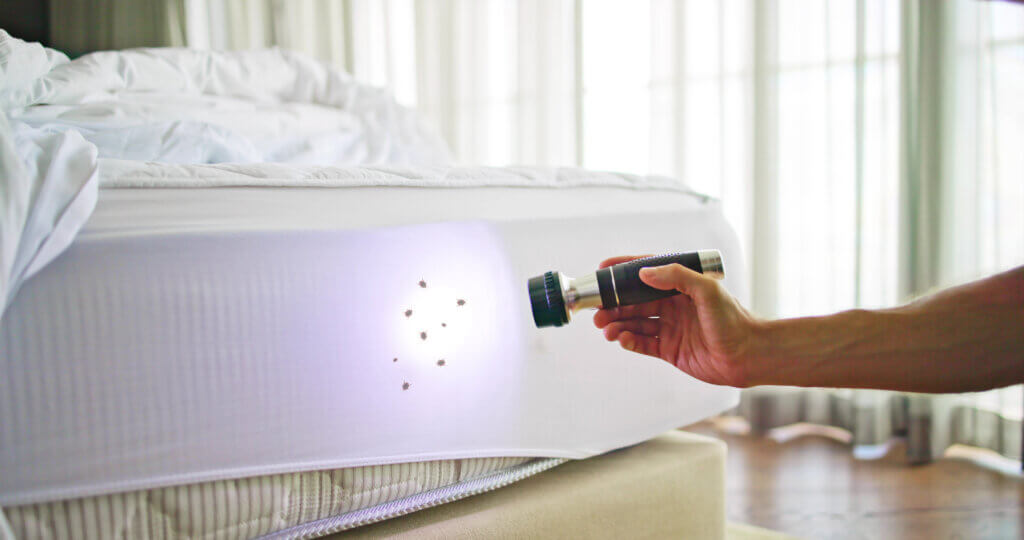
CHECK THE BED FOR BED BUGS
1. Identify bed bugs by their eggs, casings, and stains. Keep in mind that dead bed bugs tend to leave red-brown stains when they’re squashed on a mattress or section of bedding. Additionally, look for tiny white eggs or light yellow casings, which are other prominent signs of bed bug activity. Living bed bugs are small and brown, and may be found crawling around the sleeping areas.
- Small, dark dots may be a sign of bed bug waste.
- Bed bug eggs are about the size of a pinhead.
2. Examine the bare mattress and box spring for bugs. Pull off any bedding and sheets, including any elastic bedding that goes around the mattress. Look for any visible signs of bed bugs, such as eggs or the bugs themselves. Additionally, search for hard leftover casings that were shed by the bugs, or red-brown splotches on the mattress, which are both telltale signs of an infestation.
- Even if it seems tedious, it’s better in the long run if you examine all 4 corners of the mattress.
- Look carefully at the seams of the mattress, as this is a popular hiding place for bed bugs. To get a closer look beneath these seams, lift them up with the thin edge of a credit card.
3. Search under the mattress with a flashlight. Prop up the mattress with 1 arm, or ask a friend or family member to help you. Turn on your phone’s flashlight and search along the bottom of the mattress. Inspect beneath the mattress for any significant stains or splotches, as well as any eggs or casings.
- Even if the top of the mattress looks okay, the bottom of the mattress might be hiding some signs of bed bugs.
4. Inspect the bedding and sheets for bed bug activity. Pull off the quilt or duvet and look for staining or other signs of bed bugs. As an extra precaution, look over the other sheets and blankets to make sure no bed bugs have set up shop beneath the covers.
- While you don’t have to inspect every blanket, doing a quick examination might give you some extra peace of mind.
5. Shine a light behind your headboard or nightstand. Turn on your phone’s flashlight and hold it behind both your bed’s headboard and the back of your nightstand. Look for any sign of bugs crawling away, which is a big indicator that your room is infested.
- Let a hotel employee know as soon as you spot any bed bugs. The sooner you report it, the sooner you can be unwinding in a clean, bug-free room!
EXAMINE THE REST OF THE ROOM FOR BED BUGS
1. Check extra furniture in the room for bed bugs. Take a closer look at any couches, recliners, or other seating in the room. Focus especially on the seams, as this is a popular hangout for bed bugs. Before placing any clothing or other luggage on this seating, take a minute or so the inspect the entire surface of the chair or couch first.
- This can be something as simple as a desk chair, or a comfortable recliner that’s set up somewhere in the room.
2. Look through the curtains. Check your room for any side windows and curtains. Give the curtains a once-over by straightening them out and inspecting the individual creases and folds. Once again, keep an eye out for any signs of bugs, or any icky stains.
- Since curtains are typically creased and fanned out, it may take you a few minutes to check your drapes completely.
3. Study the luggage rack for any signs of bug activity. Take a closer look at the valet cart or luggage rack in your room. Check for signs of living bugs, along with any leftover casings. While this isn’t the usual hotspot, these racks can collect bed bugs from other people’s belongings.
4. Lift up framed pictures and look for bugs. If possible, pick up each framed picture and lift it up and away from the wall. Keep an eye out for any live bugs scattering away as you remove the painting, as bed bugs will sometimes take shelter there.
- Don’t worry about this if the art is firmly mounted to the wall.
5. Inspect the outside and inside of the nightstand. Kneel down and examine the screw holes and outer edges along the sides of the nightstand. As you’ve done before, look for signs of living bugs, along with their eggs and casings. Additionally, search inside each drawer to see if there are any signs of bug activity.
- Bed bugs can fit in the top of a screw!